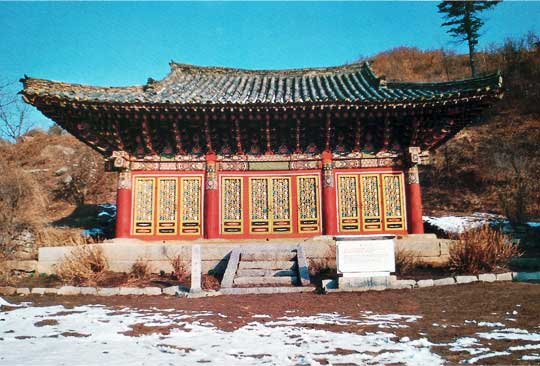Myongjok Temple
Myongjok temple is situated in Yongsam-ri, Wonsan City in Kangwon Province.
It was first built in the period of Silla and rebuilt in the days of the feudal Joson dynasty.
The present building was rebuilt in 1771 and repaired on a large scale in 1896.
At present, Taeung Hall and Simgom Hall are left in the temple.
The Taeung Hall is of 3 bays (11m) in front and 3 bays (7.8m) in sides, standing on a platform of 1 metre high.
The trapezoidal columns on trimmed corner stones are arranged widely in the middle bays and narrowly in the corner bays. Beautiful brackets with 7 layers outside and 9 layers inside cap the columns. The tongues and ancones of the layers are dovetailed together and are shaped in lotus buds with leaves. The phoenixes and the dragon heads on top of the brackets are delicate and elegant. Between the brackets are small lotus flowers decorated supporting the beams.
The smooth slope of hip-saddle roof with double eaves goes well with the building.
The Myongjok temple is also famous for its floral patterns of the doors. The doors of the middle bays are engraved with lotus and apricot patterns and the doors of the corner bays with peony and chrysanthemum patterns. In a word, the doors look like a beautiful silk cloth with different floral patterns hung down.
Dragon heads on the side beams look so alive and all the beams are colourfully painted in Moru painting style.
The Myongjok Temple is of great significance in the study of national culture as a valuable heritage showing the architectural skills of Korea, especially of the middle period of the feudal Joson dynasty.
